"If you’re looking for a modulation source the sits somewhere between a periodic LFO and a random voltage, here are a pair of chaos-based options. "

One of the challenges in music composition is finding the right balance between crafting a repeating motif to give the listener something to hang on to, and generating enough variation to keep them interested. If your music is too repetitive or too random, you risk losing their attention. In a modular synthesizer patch, this is akin to choosing between a typical periodic low frequency oscillator (LFO) or a random control voltage generator as a modulation source.,
Periodic vs. Random vs. Chaotic
“Periodic” means a modulation source takes the same amount of time for each cycle, repeating the same wave over and over again. Periodic LFOs are the most common modulation source, used for tremolo, vibrato, and chorusing effects including pulse width modulation. However, this periodic perfection can sound predictable and even artificial after awhile. Using multiple LFOs running at different, unrelated speeds is a way to extend this pattern, but eventually the pattern will repeat.
Random control voltage generators come in many forms. Smoothly varying random sources can be thought of as sine wave LFOs where both the rate and the amplitude keeps changing over time; stepped random sources are like square wave LFOs where rate and amplitude keep changing. Clocking a sample & hold at a periodic rate is a way to reinforce a tempo without seeming as machine-like as an ordinary LFO, but the result still lacks any form of repeating pattern or motif.
There is a middle path between periodic and random: chaos-based generators. Although the name may imply some form of extreme randomness, in fact chaos generators combine features of both periodic and random control voltages. The following video compares periodic, random, and chaotic control voltage sources in a couple of applications:
ELBY Designs offers two variations on this theme: the IF108 ChaQuo and the IF120 Chaotica. Below we’ll discuss chaos behavior in general, and then we’ll compare and contrast these two modules.
How Chaos Modules Work
“Chaos” is an actual branch of physics research. It applies to systems that usually stay within certain boundaries, but take a randomized path within those boundaries. Think of a moth flying around a light at night: Its path may seem random, but it tends to stay within a certain distance of that light. The same is true for a chaotic modulation source: although the exact details of the path its voltage output takes may appear to be random, its undulations has an underlying rate, and its output stays within certain bounds.
A typical chaos generator module contains a feedback loop, akin to a self-oscillating filter. When viewed over just a couple wave periods, the output of a chaos module can look quite similar from cycle to cycle, like an LFO or an oscillating filter. The difference is that a chaotic system has a non-linear element in that feedback path. This is what throws the system off track, causing it to create variations over time. For example, look at the similarities and differences between cycles of the oscilloscope trace below:
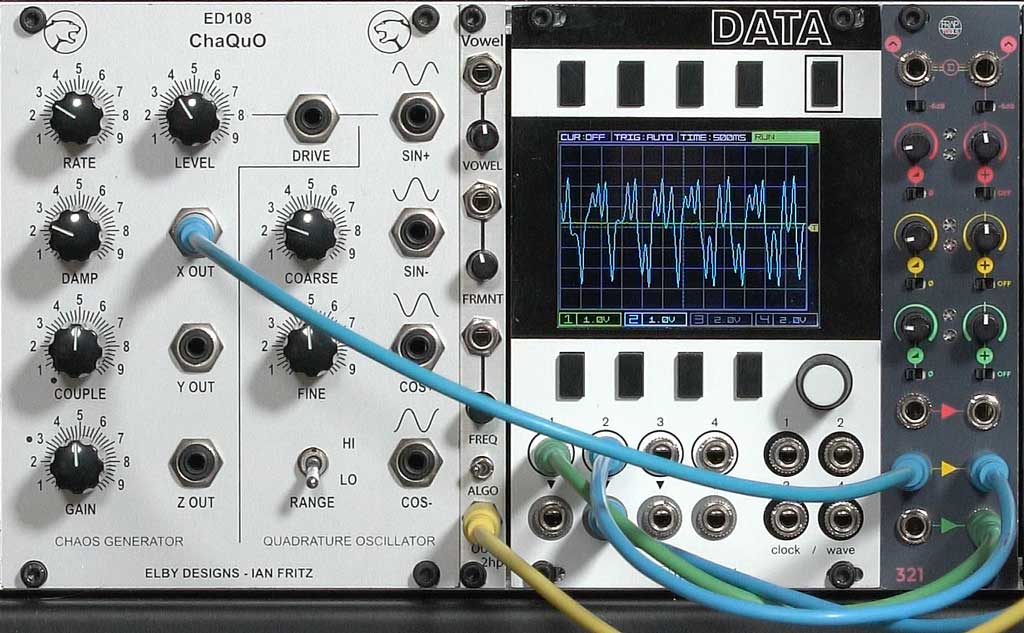
Another characteristic of chaotic systems – chaos-based synthesizer modules included – is that relatively small changes in their parameters can generate very different results. For example, the Coarse frequency of the driving oscillator for the module in these images was only changed a slight amount between the image above and the image below; note the radical differences:

A third feature of most chaos modules is that they have multiple outputs, usually taken between circuit elements in that feedback loop. The overall system may be oscillating at a given rate, but the voltage waveform at these points will usually look quite different – such as the green and blue traces below:
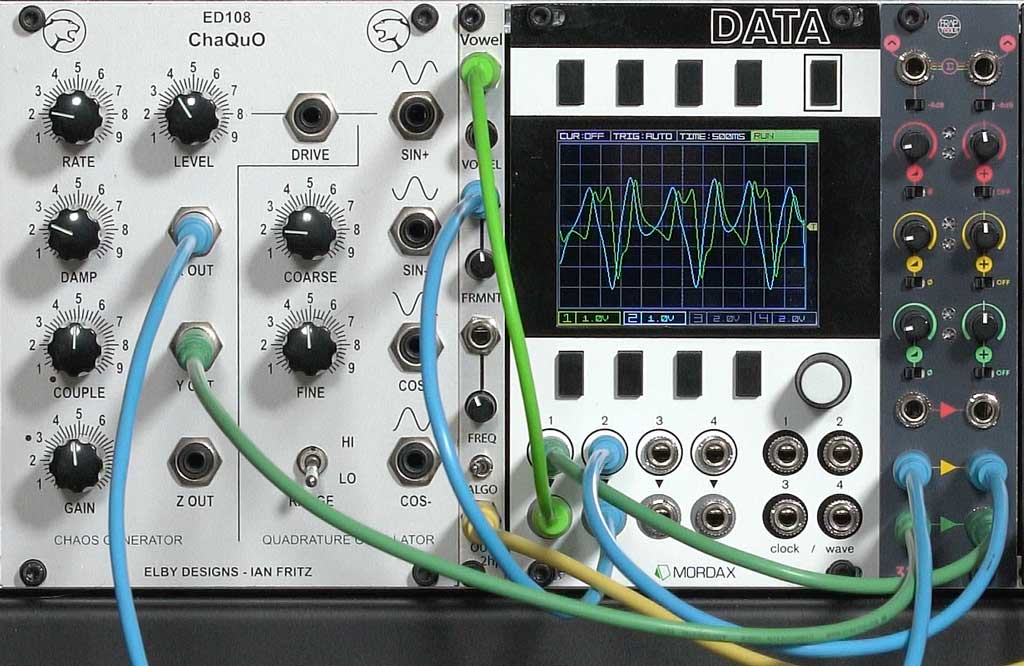
Ian Fritz’s Chaos Module Designs
Ian Fritz has been one of the leading lights in creating chaotic modulator circuits for modular synths. He has designed several different chaos modules, including the IF108 ChaQuO and IF120 Chaotica offered by ELBY Designs – both now available in more slender designs less than 60mm deep. Although ideal as sub-audio-rate modulation sources, both can be driven up into the audio range; click here to visit Ian’s YouTube channel where he demonstrates this. Let’s compare and contrast these two modules:

ChaQuO
This is the module used to create the images shown above. It combines Ian’s EZ Chaos Circuit – a classic “double well” chaos design that requires an external exciter to drive it – with a quadrature sine wave oscillator that has a frequency range of 0.03 Hz to 3 kHz. The ChaQuO does not support external voltage control, but you can patch your own external voltage-controlled LFO (or an alternative “exciter” such as an envelope generator) into its [DRIVE] input jack.
On the most basic level, the EZ Chaos circuit can be thought of as two resonant one-pole low pass filters (integrators, actually) with a pair of diodes in the feedback path to create the required non-linear element. It features three outputs, taken from after each of the two integrators plus after the non-linear element.
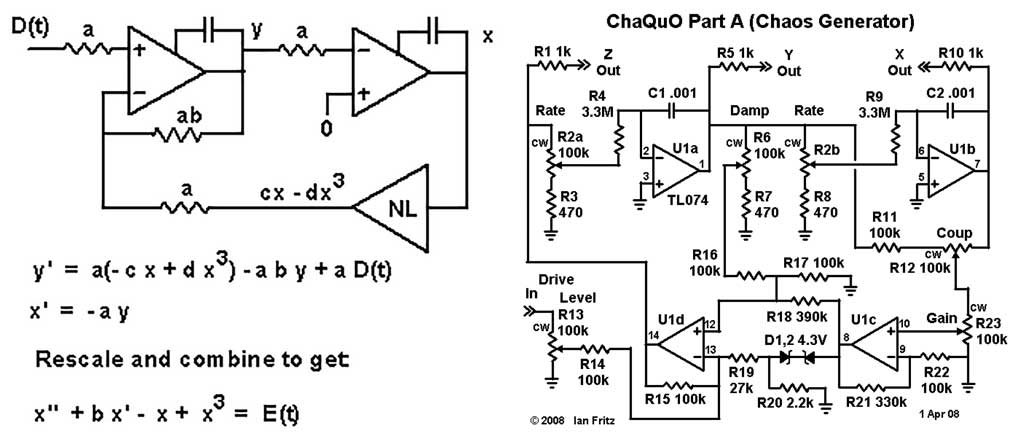
The two “wells” or “eyes” can be seen as the two centers of the roughly figure-8 pattern that the ChaQuO produces when connected to the XY inputs of an oscilloscope:
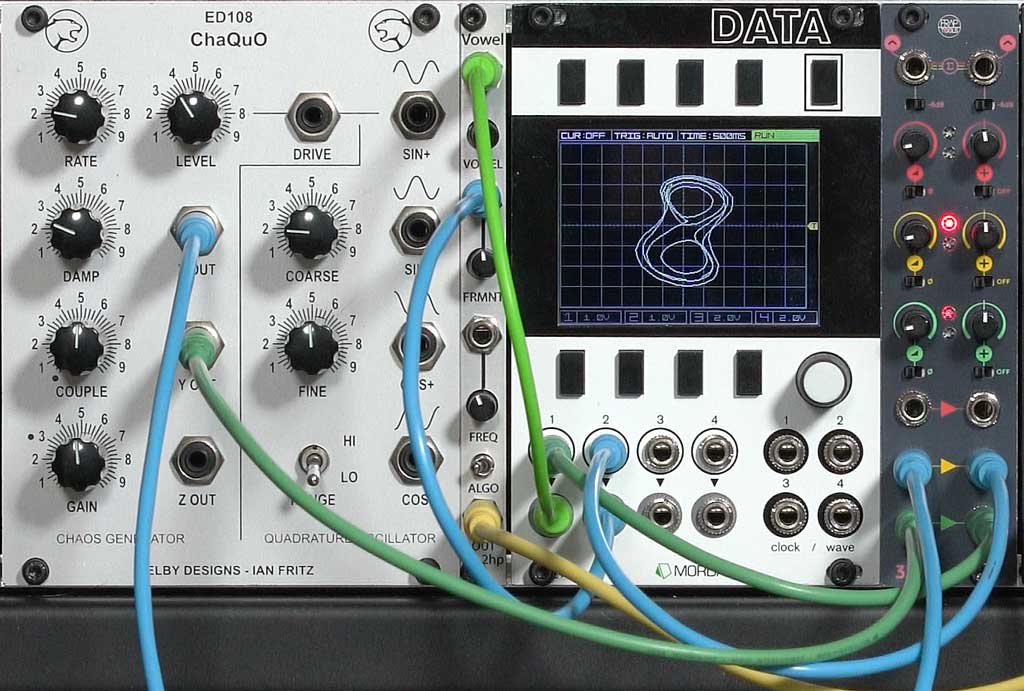
When using the ChaQuO, it is indeed helpful to think of it as an LFO driving a resonant filter. That means you have two different rates that can be played off each other: the driving LFO’s rate (its [COARSE] and [FINE] controls), and the cutoff or resonating frequency of the filter, which is set by the [RATE] control. Setting [RATE] from just below the frequency of the driving LFO to an octave or two above it is a sweet spot for creating some very interesting “beating” patterns and other interactions. The [DAMP], [COUPLE], and [GAIN] controls affect how the loop is closed for the feedback path; they interact to provide different results.
The following 2 videos explore the ChaQuO in more detail:
IF120 Chaotica
At first glance, the Chaotica looks like a version of the ChaQuO with control voltage inputs for [RATE], [DAMPING], [GAIN], and a new [OFFSET] control. However, under the hood it uses a more complex circuit featuring three integrators plus four non-linear circuit elements. As shown in the partial schematic below, each of the three integrator sections has its own output: X, Y, and Z. It does not need a separate LFO to drive it (nor does it have an external Drive input). It too can run from very slow rates up into the low audio range.
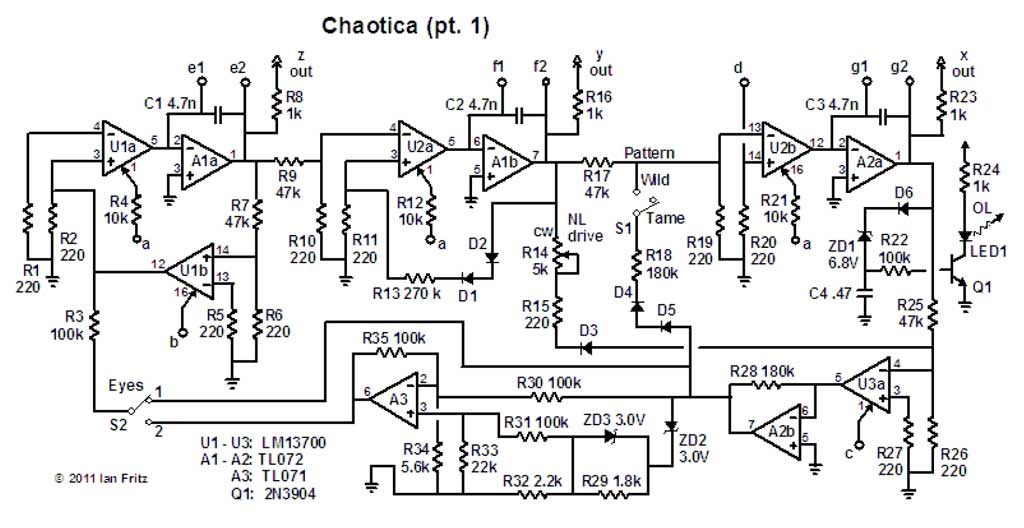
The Chaotica has a few additional features when compared to the ChaQuO beyond voltage control. For example, when a gate or trigger is sent to its [RESET/INHIBIT] input, it immediately clamps all of the integrators to 0 volts. When the gate or trigger goes low, the chaos engine is allowed to take off again from scratch, acting like a delayed LFO:

The [EYES] switch has an interesting effect on the range of the output voltages. With the [EYES] switch set to '1', the [X] output is prone to stick to positive voltages; setting [EYES] to '2' allows [X] to have pronounced negative excursions as well ([Y] and [Z] are bipolar in both cases). Similarly, if the [TAME/WILD] switch is set to 'TAME', the Chaotica’s outputs more closely resemble a cross between a swine wave LFO and smooth random source. Set that switch to 'WILD', and the system exhibits pronounced resonant ringing with higher swings in voltage overall.
If you are looking to get your sounds out of a periodic rut, but want to stop short of complete randomness, give the ChaQuO and the Chaotica a try. Both modules will provide you with hours of fruitful exploration as you explore the fascinating chaotic region between repetition and randomness.


